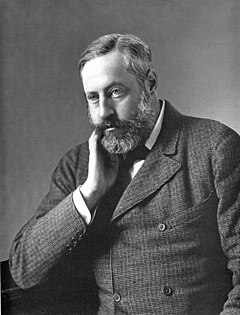John Crichton-Stuart, 3rd Marquess of Bute
| John, Marquess of Bute | |
|---|---|
 |
|
| Born |
12 December 1847 Mount Stuart |
| Died | 9 October 1900 (aged 53) |
| Resting place | Isle of Bute; Mount of Olives, Jerusalem |
| Known for | Philanthropy |
| Residence | Mount Stuart House |
| Spouse(s) | Gwendolen Fitzalan-Howard |
| Issue |
John, 4th Marquess Lord Ninian Lord Colum Lady Margaret |
| Parents |
John, 2nd Marquess Lady Sophia Rawdon-Hastings |
John Patrick Crichton-Stuart, 3rd Marquess of Bute KT, KSG, KGCHS (12 September 1847 – 9 October 1900) was a landed , industrial magnate, antiquarian, scholar, philanthropist and architectural patron.
Succeeding to the marquisate at the age of only six months, his vast inheritance reportedly made him the richest man in the world. His conversion to Catholicism at the age of 21 scandalised Victorian society and led Disraeli to use the Marquess as the basis for the eponymous hero of his novel Lothair. Marrying into one of Britain's most illustrious Catholic families, Bute became one of the leaders of the British Catholic community. His enormous expenditure on building and restoration made him the foremost architectural patron of the 19th century.
Bute died at the age of only 53 in 1900 and his heart was buried on the Mount of Olives in Jerusalem. He was a Knight Grand Cross of the Holy Sepulchre, Knight of the Order of St. Gregory the Great and Hereditary Keeper of Rothesay Castle.
The Marquess was born at the family seat of Mount Stuart, on the Isle of Bute in Scotland, to John, 2nd Marquess of Bute and Lady Sophia Rawdon-Hastings (daughter of Francis, Marquess of Hastings). The Crichton-Stuarts were illegitimate offspring of the Scottish royal House of Stuart, ennobled in the 17th century. The foundations of the family's fortunes were laid by John, 3rd Earl of Bute, Prime Minister to King George III, who married an heiress, Mary Wortley-Montagu, and attained great political prominence, although this was not accompanied by great political success. His son, John, 1st Marquess of Bute, out-stripped his father by marrying two heiresses, Charlotte Hickman, daughter of the Viscount Windsor, and Frances Coutts, of the Coutts banking dynasty. By his first marriage, the Marquess fathered John, 2nd Marquess of Bute, the founder of modern Cardiff and father of the 3rd Marquess. The 2nd Marquess was a far-sighted early industrialist and began, at great financial risk, the development of Cardiff as a port to export the mineral wealth of the South Wales Valleys. Accumulating great debts and mortgages on his admittedly vast estates, the Marquess rightly foresaw the potential of Cardiff, telling his concerned solicitor in 1844, "I am willing to think well of my income in the distance." The following fifty years saw his faith triumphantly vindicated, but the ensuing riches were to be enjoyed, and spent, by his son, "the richest man in the world", rather than himself.
...
Wikipedia
